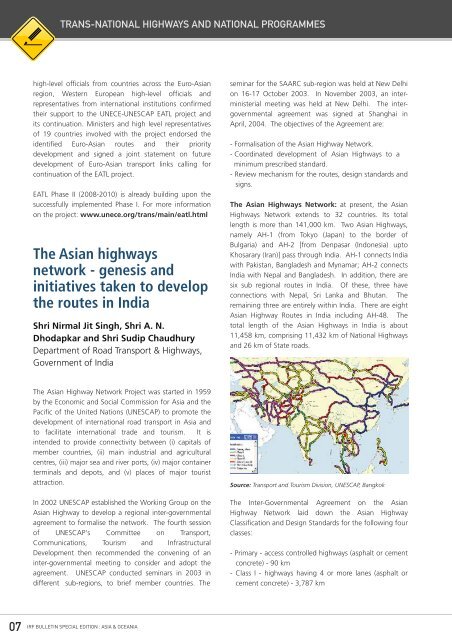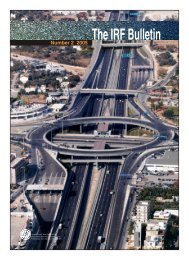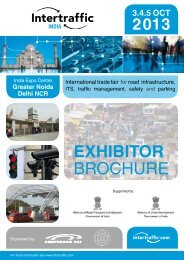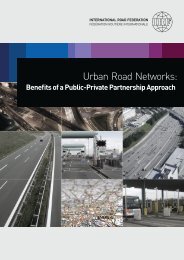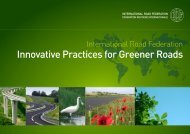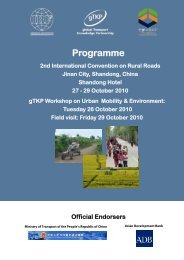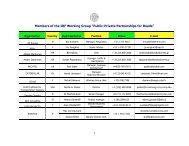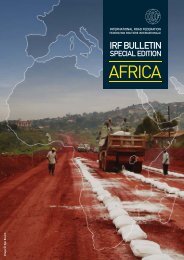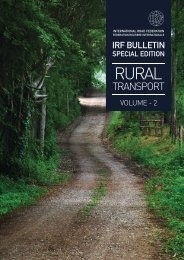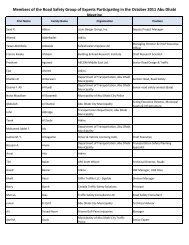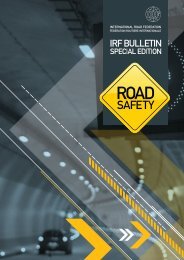Download - IRF | International Road Federation
Download - IRF | International Road Federation
Download - IRF | International Road Federation
You also want an ePaper? Increase the reach of your titles
YUMPU automatically turns print PDFs into web optimized ePapers that Google loves.
TRANS-NATIONAL HIGHWAYS AND NATIONAL PROGRAMMES<br />
high-level officials from countries across the Euro-Asian<br />
region, Western European high-level officials and<br />
representatives from international institutions confirmed<br />
their support to the UNECE-UNESCAP EATL project and<br />
its continuation. Ministers and high level representatives<br />
of 19 countries involved with the project endorsed the<br />
identified Euro-Asian routes and their priority<br />
development and signed a joint statement on future<br />
development of Euro-Asian transport links calling for<br />
continuation of the EATL project.<br />
EATL Phase II (2008-2010) is already building upon the<br />
successfully implemented Phase I. For more information<br />
on the project: www.unece.org/trans/main/eatl.html<br />
The Asian highways<br />
network - genesis and<br />
initiatives taken to develop<br />
the routes in India<br />
Shri Nirmal Jit Singh, Shri A. N.<br />
Dhodapkar and Shri Sudip Chaudhury<br />
Department of <strong>Road</strong> Transport & Highways,<br />
Government of India<br />
seminar for the SAARC sub-region was held at New Delhi<br />
on 16-17 October 2003. In November 2003, an interministerial<br />
meeting was held at New Delhi. The intergovernmental<br />
agreement was signed at Shanghai in<br />
April, 2004. The objectives of the Agreement are:<br />
- Formalisation of the Asian Highway Network.<br />
- Coordinated development of Asian Highways to a<br />
minimum prescribed standard.<br />
- Review mechanism for the routes, design standards and<br />
signs.<br />
The Asian Highways Network: at present, the Asian<br />
Highways Network extends to 32 countries. Its total<br />
length is more than 141,000 km. Two Asian Highways,<br />
namely AH-1 (from Tokyo (Japan) to the border of<br />
Bulgaria) and AH-2 [from Denpasar (Indonesia) upto<br />
Khosarary (Iran)] pass through India. AH-1 connects India<br />
with Pakistan, Bangladesh and Mynamar; AH-2 connects<br />
India with Nepal and Bangladesh. In addition, there are<br />
six sub regional routes in India. Of these, three have<br />
connections with Nepal, Sri Lanka and Bhutan. The<br />
remaining three are entirely within India. There are eight<br />
Asian Highway Routes in India including AH-48. The<br />
total length of the Asian Highways in India is about<br />
11,458 km, comprising 11,432 km of National Highways<br />
and 26 km of State roads.<br />
The Asian Highway Network Project was started in 1959<br />
by the Economic and Social Commission for Asia and the<br />
Pacific of the United Nations (UNESCAP) to promote the<br />
development of international road transport in Asia and<br />
to facilitate international trade and tourism. It is<br />
intended to provide connectivity between (i) capitals of<br />
member countries, (ii) main industrial and agricultural<br />
centres, (iii) major sea and river ports, (iv) major container<br />
terminals and depots, and (v) places of major tourist<br />
attraction.<br />
In 2002 UNESCAP established the Working Group on the<br />
Asian Highway to develop a regional inter-governmental<br />
agreement to formalise the network. The fourth session<br />
of UNESCAP's Committee on Transport,<br />
Communications, Tourism and Infrastructural<br />
Development then recommended the convening of an<br />
inter-governmental meeting to consider and adopt the<br />
agreement. UNESCAP conducted seminars in 2003 in<br />
different sub-regions, to brief member countries. The<br />
Source: Transport and Tourism Division, UNESCAP, Bangkok<br />
The Inter-Governmental Agreement on the Asian<br />
Highway Network laid down the Asian Highway<br />
Classification and Design Standards for the following four<br />
classes:<br />
- Primary - access controlled highways (asphalt or cement<br />
concrete) - 90 km<br />
- Class I - highways having 4 or more lanes (asphalt or<br />
cement concrete) - 3,787 km<br />
03 07<br />
<strong>IRF</strong> BULLETIN SPECIAL EDITION : PUBLIC-PRIVATE ASIA & OCEANIA PARTNERSHIP


